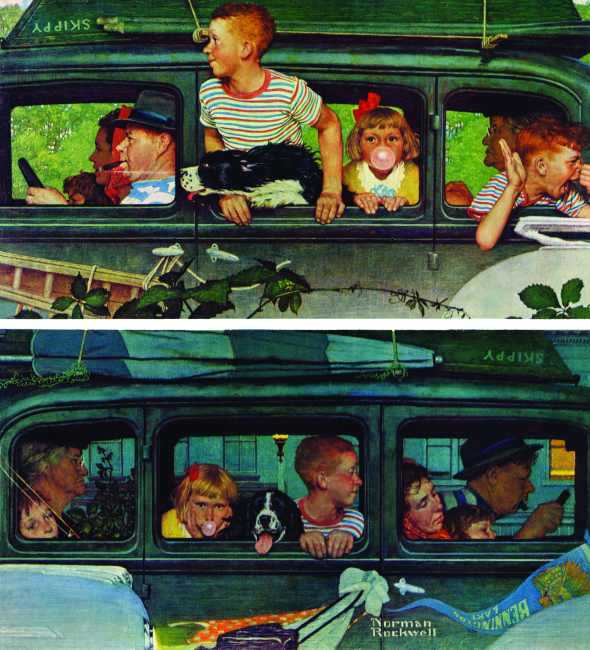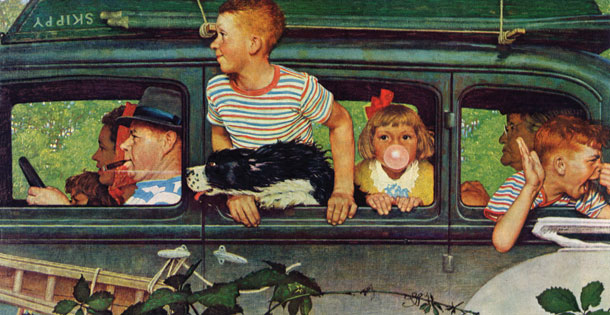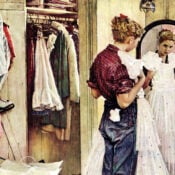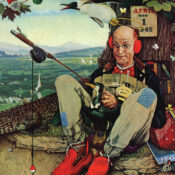
After WWII ended, America was on the move. With an economy on an upswing and higher levels of disposable income, record numbers of families packed up the station wagon, loaded kids in the backseat, and hit the open highway.
Norman Rockwell celebrated the emerging trend in the August 30, 1947, Post cover Going and Coming. While seasonal or topical subjects often inspired Rockwell’s covers, in this two-panel portrait of a family en route to and from a summertime trip we find an example that’s both.
In Going, Dad confidently grips the wheel leading the expedition with Mom at his side cradling the youngest. Anticipation spills into the backseat where big brother and pooch lean into the wind, while little sister blows a bubble about to pop as her brother razzes oncoming cars. Unfazed by it all, Grandma sits stone-faced, staring straight ahead.
In Coming, the excitement has fizzled. Pop struggles to keep his eyes open. Mom, still cradling little sis, drifted off miles ago, while the boys, pooch, even the wide-eyed bubble blower are running out of steam. Unfazed by it all, Grandma sits stone-faced, staring straight ahead — did she even get out of the car?
To help readers unravel the story line, Rockwell provides clues. In the lower panel, to signify nighttime, he shows the tiniest portion of a lighted lamppost through the car window. Another clue: The pennant dangling from the door tells us the outing was to Bennington Lake, where — judging from the fishing pole sticking out the rear window and weathered rowboat lashed to the roof — Dad managed to get in some angling. Rockwell also lets us know Grandma indeed exited the car — if only for a souvenir plant.
There’s a familiar feeling to the entire scene. (We’ve all been on family outings like this.) You can almost hear the eternal refrain, “Are we there yet?”
Become a Saturday Evening Post member and enjoy unlimited access. Subscribe now




Comments
Some anomali. Where is the other red haired twin. Why the cross on the door. Is that a wreath on granny’s lap. Did a tragedy take place at the lake??
Even after extended examination, some elements of this painting continue to baffle me. Can someone identify for me the ladder-like object tied to the door handle in the top panel? And in the same panel, can someone explain the purpose of the foregrounded plant? Although in front of everything else, it plays a minor role in the overall composition. It’s placement suggests a vantage point not in an adjacent car, which the field of vision would indicate, but behind some roadside foliage, which would move the vantage point to the other side of the road, with three entire lanes in between. This in turn suggests a telescopic magnification from a relatively distant viewpoint. If this is the case, why choose a vine-like plant, like one might see climbing a house’s outer wall, rather than some sort of shrubbery, which would be more commonly seen on a roadside? Perhaps it’s meant to be demi-decorative, more figurative than narrative? Since there’s no balancing element to be found in the lower panel, or anywhere else for that matter, this seems capricious indeed. All the painting’s elements excepting this one are devoted to the painting’s narrative, leaving the vine to seem to be part of a different painting altogether.
With respect to a less fundamental (seeming) anomaly, I’m mildly perplexed as to the identity of the items tied to the door handle in the bottom panel. They seem to be garments of some sort; perhaps swimwear and towels for drying? I was born nine years after the painting, and my father used to take the seven of us on outings much like the one depicted, but I cannot remember ever seeing items tied to car door handles.
Having said all that, I wouldn’t have been drawn to these small things if I didn’t love this picture so much, and wasn’t drawn to examine it so closely, the better to appreciate its charms.
I welcome any thoughts anyone might have on these small but (for me) nagging details.
Actually, this article is wrong. 🙂
The artist is playing a trick on us, as the perspective of the viewer changes from the top picture to the bottom.
On the top picture, the family are travelling to their holiday destination.
Then the observer crosses the road.
Now the car is seen again at night, but it’s travelling in the ‘same’ direction. So they never reached their location, instead they all went on a big loop.
Evidence – the plant reflected in the door door in the top panel, is seen again, but this time through the window of the car.
One of my favorite pictures, because of the way the artist plays with our mind.
One of my favorite covers of Saturday Evening Post. Great face expressions by the Norman Rockwell.